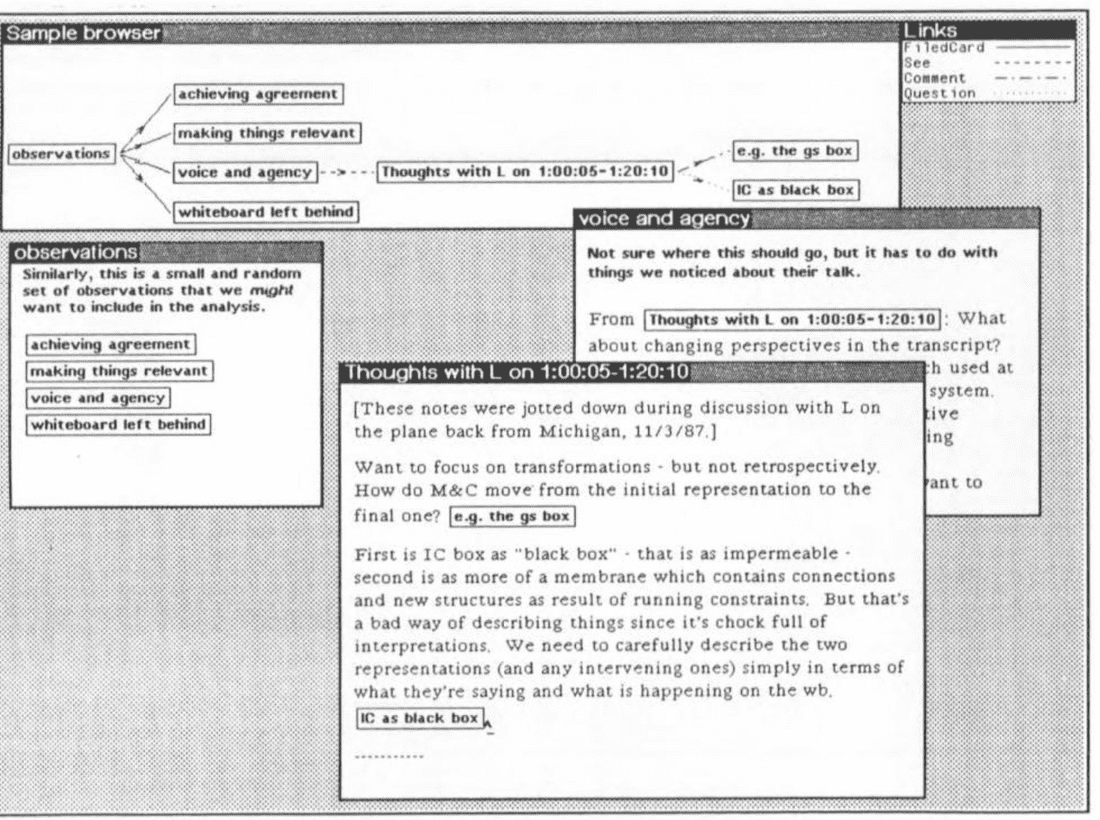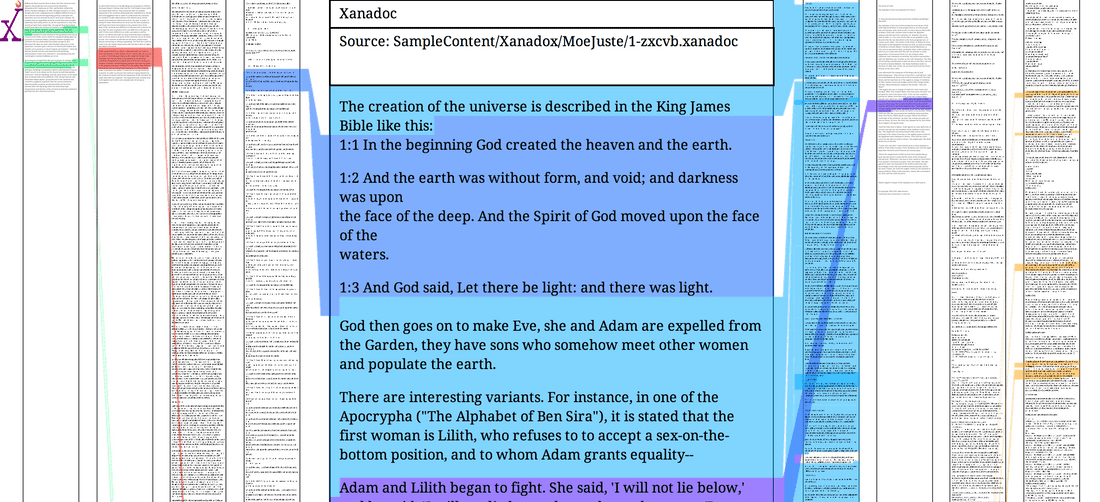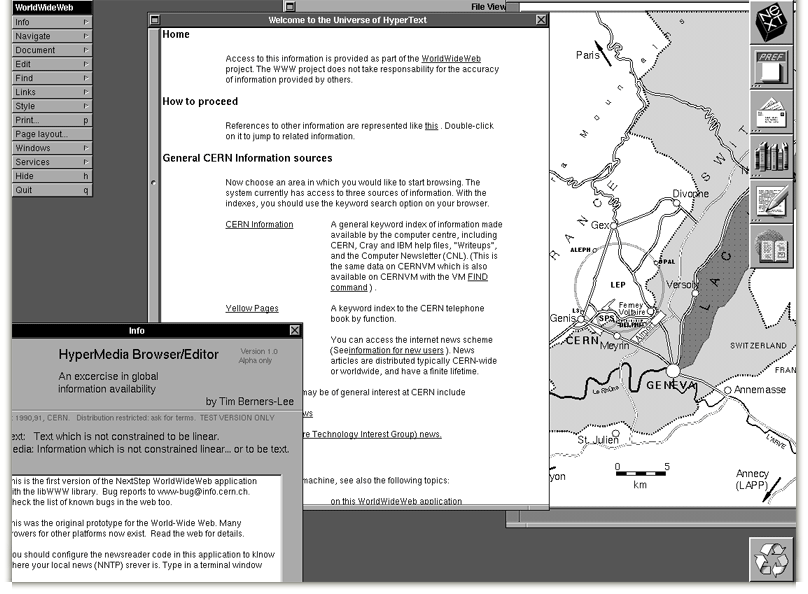Hypertext Tools of the 1980s
This article briefly reviews some hypertext systems of the 1980s. The pre-internet era was full of wonderful and powerful systems that are now forgotten, but we can definitely learn from them and try to understand why we had a huge recession in the 1990s and 2000s and why we enjoy it now The revival of the hypertext system. Interestingly, the hypertext systems of the 1980s outperformed the most modern web applications in some functions.
Let's evaluate these tools on a Human / Organization / World scale. Everyone has some knowledge that usually expands over a lifetime. The same concept applies to organizations and the world as a whole. Hypertext systems are a natural fit for this scale.
Human-level
There are several noteworthy systems in this part: Guide (1982), NoteCards (1984), HyperCard (1987). HyperCard is the most famous, but I want to focus on NoteCards (1984).
NoteCards (1984) were developed by Xerox Palo Alto Research Center ( Xerox PARC ) to help people process ideas. This is a very rich system with several building blocks: Notecard, Link, Browser card, Filebox.
- Notecard: A notecard is an electronic version of a 3x5 paper note. Each note card contains any amount of some editable content, such as a piece of text, a structure diagram, or a bitmap image.
- Link: Links are used to connect individual note cards into a network or structure of related cards. Each link is a typed, directed connection between a source card and a destination card. The type of link is a user-selected label that specifies the nature of the relationship represented.
- Browser card: A browser is a notecard that contains a map of the notecard network.
- Filebox: Fileboxes are specialized cards that can be used to organize or sort large numbers of notecards. They are designed to help users manage large networks.

In summary, you can create content with Cards , organize Cards with Links and Filebox , and navigate with Browser and Links . As you can see, there are only two main structures: Cards and Links . Cards do not have Blocks functionality (like Roam software does), so each card must be very small to keep the connection working.
People use NoteCard for all kinds of things: project management, engineering design, educational systems, and more. In a later version, NoteCard has increased the possibility of collaboration and is therefore also used in small workgroups. NoteCards pioneered concepts such as typed links and graphical overviews of hypertext documents. Even by today's standards, the system is very feature-rich.
Organization level
Augment/NLS (1960s) was the first connected knowledge management system designed to work at the organizational level. The team uses NLS for everything: documentation, specs, bug tracking, etc.
In the Augment project, researchers store all of their papers, reports, and memos in a shared " journal ", enabling them to include cross-references to other work in their own writing. This " journal " has over 100,000 entries - Jakob Nilsen, The History of Hypertext
In general, collaboration software was relatively difficult to create prior to the advent of the Internet. You have to install a client on each machine to enable collaboration, and connections are slow, so you have to design such systems very carefully to make them usable. Perhaps this is why we see many examples of human-level tools and very few examples of organizational-level tools.
Intermedia (1985) was created by Brown University primarily for the creation of educational programs. The main paradigms are:
- Links are as easy as Copy/Paste
- Embed in all applications
- There is no difference between reading and writing
- Multi-User and Networking

You'll be surprised if we dig into the Intermedia feature set. Let's enumerate:
- Webs (different sets of links on the same set of documents)
- Bidirectional links, sets (anchors), one-to-many links
- Full Text Search
- Local map (view links inside and outside the document and history of subsequent links)
- Comments (multiple users comment on documents using warm links)
- Various applications (timeline, drawing, text, animation, etc.)
- Templates (predefined, pre-linked documentation sets)

I want to highlight two cool ideas: it can create diagrams and link objects to specific parts of any document. It can also create many webs on top of documents. Each student is able to create their own network (web). This is a forgotten concept, but it can be useful in a collaborative environment where we can share knowledge.
I recommend this detailed Intermedia demo to the curious.
We have no comparable system today. Some systems are moving in this direction (eg Notion, Coda), but they are not there yet. Information processing within an enterprise is like the Internet in 1997. You have many disconnected tools that you have to browse or search through to find what you need.
The real problem is that in an organization where knowledge management and work management are separate, there are different tools for doing these things. In fact, the current status quo is that there is a set of tools dedicated to dealing with structured information (e.g. Asana, Jira, Salesforce, Intercom) and very few tools for dealing with unstructured information (e.g. Google Docs, Confluence, Miro, Slack). This is wrong because the dichotomy of knowledge and work management does not exist in reality.
The World
Oddly enough, we already have some good-enough knowledge-organization solutions (WWW) that apply to the whole world, but no good solutions at a more fundamental level. In fact, it is relatively easy to create a tool that simplifies knowledge management for individuals. Creating similar solutions for organizations is more difficult. But for the world as a whole, it's almost impossible. But that's how it happened...
As far as I know, there are only two attempts to create hypertext systems in the world: Xanadu and WWW. Xanadu was the first system that tried to conquer the whole world. The idea is great, and many of Ted Nelson 's ideas still apply today: user identification , content authoring , documents compositions , permissions, micropayments, content Version control, links that always work.
Ted Nelson pursued this idea his whole life, but he couldn't release something viable before the WWW, and then it was too late.
Why did Xanadu fail? Ted Nelson was too ambitious. His vision is top notch, but I think it should be narrowed down to the individual/organizational level to be successful. In this smaller field, his chances are much better. Furthermore, we think he overestimates the importance of embeddings ( transclusions ), parallel documents ( parallel documents ) and versioning ( versioning ). These things are hard to pull off and just drag the whole idea in the wrong direction. The main elements in the hypertext system are nodes and links .

Why did WWW succeed? WWW changed the world because it was so simple. There are already connected networks around the world, and Tim-Berns Lee combined hypertext and the Internet with URI, HTTP, and HTML technologies.

What are we missing now? There are a lot of little things, but here are the three that I think are the most important:
- We have lost the equality of writing and reading. Content creation often requires a standalone website.
- It's hard to collaborate on arbitrary content. Annotations, comments, personal link layers - we've tried to get around this with browser extensions and special apps like Evernote, but there's no good solution yet.
- There are no two-way links, and embedding is very limited. Documentation may disappear and links may be broken.
Review and Conclusion
Let's quickly explore these systems from the perspective of augmenting intelligence .
A tool capable of augmenting human intelligence should bring structured and unstructured information together in one place and be able to collaboratively create, blend, connect, visualize and retrieve information. ( A tool that can augment human intelligence should accumulate structured and unstructured information in a single place and have instruments to collaboratively create, mix, connect, visualize and retrieve information. )
How did all the systems of the 1980s fit into this concept?
- They support authoring tools (such as text and diagram creation), but do not support integration with other tools. In fact, it's not that important because without the Internet, information is in silos and difficult to extract and integrate.
- They mainly deal with unstructured contexts and do not attempt to place ontologies on top of unstructured data.
- They connect information very well (even by today's standards). Two-way links are common.
- They visualize information in a very limited way, usually only through network graphs.
- Overall, they don't support a decent mix of information. For example, there are no blocks in the document, no embedding and very limited visualization.
This image summarizes support for intelligence augmentation by pre-Internet hypertext systems.

As you can see, these tools are primarily focused on creating and connecting unstructured information. Interestingly, that's also Roam's focus, but it's more advanced in blending and structuring information.
Here, we conclude the historical review with some observations:
- In the pre-Internet era, the hypertext system was quite advanced and made great progress. They are effective for both individuals and small work groups.
- WWW was a very simplified version of the hypertext system, but it conquered the world. Then it became synonymous with the standard model and hypertext. All new hypertext systems are implemented for the Web and are constrained by the WWW model (Wiki, blog, etc.).
- Initially, the technology was not mature enough to create complex internet-based systems. It took us 20 years to regain this possibility. So we had a huge gap in progress between 1990 and 2010. As a side effect of these 20 years of stagnation, the old and advanced hypermedia systems were forgotten.
- Now we are seeing a revival of hypertext systems: Notion, Roam, and Fibery are moving in this direction, rediscovering the knowledge lost in the 1980s.
Compiled from: Hypertext tools from the 80s
Like my work? Don't forget to support and clap, let me know that you are with me on the road of creation. Keep this enthusiasm together!




